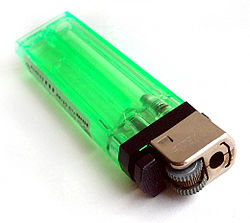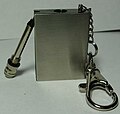Lighter: Difference between revisions
m Undid revision 244334112 by 194.83.4.8 (talk) |
|||
| Line 17: | Line 17: | ||
The development of lighters accelerated during the first World War. Soldiers used [[match]]es to find their way in the dark, but the intense initial flare of matches gave away their position, and many lives were lost because of this. So the need for fire without a large initial flare was born. Inventors started improving the design of lighters and by 1918 when the war ended, they were able to be produced fast, easier and cheaper. |
The development of lighters accelerated during the first World War. Soldiers used [[match]]es to find their way in the dark, but the intense initial flare of matches gave away their position, and many lives were lost because of this. So the need for fire without a large initial flare was born. Inventors started improving the design of lighters and by 1918 when the war ended, they were able to be produced fast, easier and cheaper. |
||
<ref>{{cite web |title=History of Lighters |url=http://www.bugstores.com/history_of_lighters.htm| author=Jason Virga |date=2006-02-21 |publisher=Jason Virga}}</ref> |
<ref>{{cite web |title=History of Lighters |url=http://www.bugstores.com/history_of_lighters.htm| author=Jason Virga |date=2006-02-21 |publisher=Jason Virga}}</ref> |
||
no no no no liar |
|||
==Safety== |
==Safety== |
||
Revision as of 08:52, 10 October 2008


A lighter is a portable device used to create a flame. It consists of a metal or plastic container filled with lighter fluid (usually naphtha or liquid butane under pressure), as well as a means of ignition and some provision for extinguishing the flame, by depriving it of either air or fuel.
Operation
Lighters using naphtha have a wick which is immersed in the fluid and becomes saturated. This type usually has a fiber packing material which absorbs the liquid to keep it from leaking. They also must have an enclosed top to prevent the volatile liquid from evaporating, and to conveniently extinguish the flame. Butane lighters have a valved orifice that meters the butane as it escapes as a gas.
A spark is created by striking metal against a flint, or by pressing a button that compresses a piezoelectric crystal, generating a voltaic arc (see Piezo ignition). In naphtha lighters the liquid is volatile enough that flammable gas is present as soon as the top of the lighter is opened. Butane lighters combine the striking action with the opening of the valve to release gas. The spark ignites the flammable gas causing a flame to come out of the lighter which continues until either the top is closed (naphtha type), or the valve is released (butane type).
A metal enclosure with air holes generally surrounds the flame, and is designed to allow mixing of fuel and air while making the lighter less sensitive to wind. The high energy jet in butane lighters allows mixing to be accomplished by using Bernoulli's principle, so that the air hole(s) in this type tend to be much smaller and farther from the flame. In a plastic butane lighter this metal enclosure also regulates the distance from the valve to the beginning of the flame. If the flame is too close to the valve, there is a risk of the flame melting some, most, or all of the plastic components of the lighter which are in close proximity to the valve.
History
The first lighter, Döbereiner's lamp, was invented by Johann Wolfgang Döbereiner in 1823. It stayed in production until 1880.
The development of lighters accelerated during the first World War. Soldiers used matches to find their way in the dark, but the intense initial flare of matches gave away their position, and many lives were lost because of this. So the need for fire without a large initial flare was born. Inventors started improving the design of lighters and by 1918 when the war ended, they were able to be produced fast, easier and cheaper. [1]
Safety
Two technical standards relate to the safety of lighters. The International Standard EN ISO 9994:2002[2] establishes non-functional specifications on quality, reliability and safety of lighters and appropriate test procedures. For instance, a lighter should generate flame only through positive action on the part of the user, two or more independent actions by the user, or an actuating force greater than or equal to 15 N. The standard also specifies other safety features, such as as the lighter's maximum flame height and its resistance to elevated temperatures, dropping, and damages from continuous burning. However, the standard does not include child resistance specifications. In addition, the European standard EN 13869:2002 [3] establishes child-resistance specifications and defines as novelty lighters those that resemble another object commonly recognized as appealing to children younger than 51 months, or those that have entertaining audio or animated effects. As matches, lighters, and other heat sources are the leading causes of fire deaths for children,[4] many jurisdictions, such as the EU,[5] have forbidden the marketing of novelty or non-child resistant lighters. Examples of child resistance features, include the use of a smooth or shielded spark wheel.
Car cigarette lighters
Most cars are equipped with an electric cigarette lighter plug that fits in the socket. Its internal heating element becomes glowing orange hot in seconds when the device is activated, and is capable of lighting cigarettes, cigars and tinder (among other things).
The lighter's socket doubles as a 12 volt power outlet that can be used to power many small electrical devices. In some newer cars, due to the decreasing popularity of smoking in some countries and the popularity of in-car electronics, the lighter plug has been omitted while leaving the socket behind as a power source.
In pop culture
During slow songs at live concerts, particularly power ballads, concert goers often wave lighters in the air. In recent years, this tradition is being at least partly superseded by the waving of mobile phones. It may be that this occurs, as fewer people have lighters on them than in previous years due to lessened smoking rates, and because mobile phones can record live bands.

According to an interview by Matthew Alice, the use of lighters in concerts started due to the influence of several sources, making it difficult to trace. First, there is the theory that the practice simply started at a Neil Diamond concert of 1972 or a Bob Dylan concert at 1974, because the audience had lighters available. Another theory is that the gesture is symbolic of songs with flames mentioned, such as the Doors' "Light My Fire." Another theory is that this practice came out of a performance during Woodstock where candles (rather than lighters) were held aloft, and evolved from this.[6]
In addition, it is frequently commented that lighters with opaque fuel containers (such as the standard Bic type) succeed in striking a flame more often than lighters with transparent plastic for the fuel holder (like the German-made Tokai lighters). Although the transparent plastic itself is often blamed, this is more likely to be a difference in the quality of manufacturing for the ferrocerium components: see the list of lighter manufacturers below.
The Discovery Channel Mythbusters tested urban legends involving lighters and how they might accidentally or carelessly explode.
See also
- Disposable lighter
- Match
- Car adaptor
- Ferrocerium
- Permanent Match
- List of lighter manufacturers http://www.cpsc.gov/businfo/clmfgimp.pdf
Notable lighter companies
- Silva compass
- Colibri
- Windmill
- Solo
- Brunton
- Zippo (naphtha type)
- Ronson's Lighters
- Société Bic (butane type)
Images
-
Various kinds of lighters
-
Lit 1968 slim model Zippo lighter
-
Disposable lighter with flame
-
A storm-proof piezo-ignited lighter/rope burner
-
Permanent Match, opened
References
- ^ Jason Virga (2006-02-21). "History of Lighters". Jason Virga.
- ^ ISO, ed. (2005), Lighters — Safety specification (PDF), Geneva: ISO, p. 32, ISO 9994:2005(E)
- ^ The European Committee for Standardization, ed. (2002), Lighters — Child-resistance for lighters — Safety requirements and test methods, Brussels: CEN, EN 13869:2002
- ^ US Fire Administration (2008-03-12). "Match and Lighter Safety". FEMA.
- ^ European Commission (2006), 2006/502/EC: Commission Decision of 11 May 2006 requiring Member States to take measures to ensure that only lighters which are child-resistant are placed on the market and to prohibit the placing on the market of novelty lighters, pp. 41–45, OJ L 198, 20.7.2006
- ^ What band started the tradition of holding up lighters at concerts?





